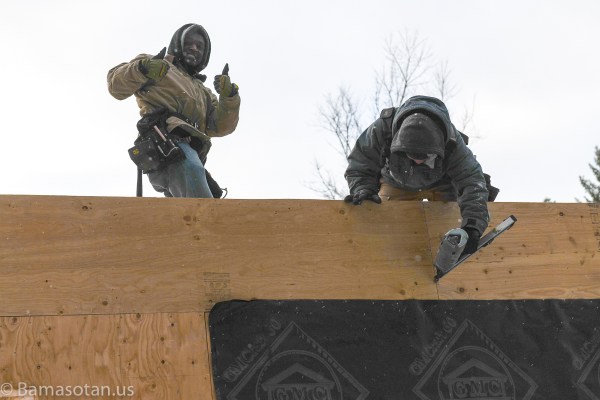Studio I
A late post from early February…
Many Minnesotans don’t tend to let the weather slow them down much. Here on our frozen lake we have someone on an ATV pulling someone on a sled, a couple of snowmobiler’s, several pickup trucks whose owners are presumably ice fishing and a couple of ice houses. This is from our master bedroom.
They got started on framing our detached garage (+ shop/studio above). This was originally to be attached but we felt that would be too much house next to our neighbor’s yard which led us to build this portion detached. The major downside is that the upper level is not as large as it would have been (and then there’s a little issue of cost for a separate structure). OTOH there are some advantages like being able to do solar on here without it being on our main house, keeping woodworking dust/chemicals away from main house, etc.

This went much faster than our main house. Day 2 and they’re already on second floor trusses.


Caulk keeping warm.
Terry setting the backing for the elevator. That’s one heavy beam he’s lifting.

Finishing up on Day 2.
Elevator shaft is ready for the elevator.
I didn’t get to know these guys but Caleb who runs the crew is a friend of Terry’s who recommended them and that’s worth something. They did indeed seem like a good crew. 

It’s snowing on Day 3 but they kept going.

We enjoy cooking and one thing I really dislike is the lingering odors of meals past (and sometimes of meals present). Consumer range hoods have several design faults but one key fault is a lack of containment area which is basically just a big fat open area to contain effluent until it can be exhausted. No consumer hood we found can keep up with bursty cooking like sautéing, pan frying or wok which means that the effluent of odors, grease, steam, and byproducts of gas combustion spread throughout your house and can take a day or three to eliminate. We considered mounting a consumer hood up high in a hood surround to create a containment area but this wasn’t a great solution and we’d still have to figure out how to make the control switches accessible.
Commercial hoods are generally 36” deep (front to back) which is about 6” deeper than we wanted. 36” will capture near 100% of effluent but sticks out in the kitchen a considerable bit. From discussions with several engineer types a 30” would get about 92% of effluent which would be good enough (the best consumer hoods like Wolf capture less than 50% so 92% is a huge improvement and is due to the larger capture aperture and having a containment area that keeps effluent from rolling out from under the hood). One option we looked at was to use a CaptiveAire ‘back shelf’ hood which is 30” deep. But it is partially open in front so my drawing below was to communicate an option for covering it a bit with the decorative surround.
In the end the great folks at Horizon Equipment stepped in to provide us a solution with a 30” deep commercial hood from Accurex. More on this later.

Ready for the steel ridge beam.
Aaron working on the stone near the master bedroom window.
Closed cell spray foam Insulation in the chimney chase. There are a few problems with this. The biggest is the narrow cavity in the middle that was less than 1/2” thick along the left side. It should be at least 3” and ideally over 5” thick throughout the cavity. In the middle of the larger cavity to the left the foam is less than 2” thick in the middle. Finally, the sides of the studs are not insulated. Studs are not a good insulator and actually transmit heat out of the house quite efficiently in what’s called Thermal Bridging. The exposed sides of the studs will thus act as Cold Sinks (similar to a heat sink on a bit of electronics). Without any insulation on them or in the cavity between the spray foam insulation and the sheetrock the cavity will become quite cold and may significantly reduce the insulating properties of the wall.
This is an issue that we are exploring to determine the best way to move forward. One option is a flash coat of closed cell to seal everything up and then fill out the cavity with open cell or fiber insulation. My guess is that in a few years time we’ll look back on closed cell foam filling only part of the cavity like this as a huge blunder.
First color samples for siding. These were all much too dark.
Krause Media Solutions getting ready to install AV and security.
And this is where things stood when we left for Finland.

Recent Comments